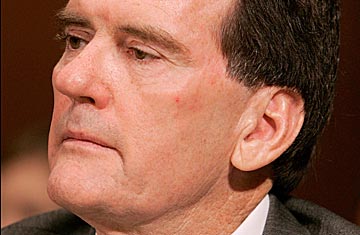
Judge John McCarthy Roll was among the six shooting victims who died during in Tucson on Jan. 8.
For a moment, U.S. District Judge John M. Roll seemed as likely the main target of the Tucson massacre as Congresswoman Gabrielle Giffords. In 2009, Roll had come under threats severe enough that he and his family were placed under 24-hour protection by the U.S. Marshals Service. After he ruled that a high-profile suit brought by a group of Mexican immigrants could proceed, his phone lines were deluged with angry callers — including at least four that threatened violence.
At the time, the U.S. Marshal for Arizona told the Arizona Republic that the threats had been egged on by radio talk-show hosts critical of Roll's decision. Critics began sharing his personal information on Web sites as the rhetoric became more heated. The round-the-clock protection lasted a month, though Roll ultimately decided not to press charges against the callers. He told the Arizona Republic that the month under protection had been stressful, but that he had been grateful for the security. "It was unnerving and invasive. ... By its nature it has to be," Roll said.
For some members of the judiciary, the news that Roll was among the six who died during the shooting spree in Tucson was unsettling in ways that went beyond personal grief from those who knew and served with Roll, who had been placed on the bench by President George H. W. Bush in 1991 at the urging of Senator John McCain. Just minutes after learning of the slayings, U.S. District Judge Robert Gettleman of Chicago told TIME in an email that the news of the murder was "very disturbing... Just when we were beginning to feel more secure." Wrote Gettleman, "As judges I'm confident most all of us would like to feel safe as participants in our communities without believing we need special protection. I hope that's the norm, although recent events may indicate otherwise. We certainly don't want to live our lives like judges in some other countries (like Russia, Kenya) must, under constant guard."
In an interview last May with Ryan J. Reilly of mainjustice.com, the director of the U.S. Marshals Service, John Clark, said threats against judges are on the rise. "In today's world there are more individuals who are more prone to threatening judges. I think a lot of it has to do with the availability of information with the use of technology and the Internet. Individuals can find out more about particular cases and judges' decisions. They can use the Internet sources to find out more about the judge."
Many other judges know what it's like to live under threat — and some know the consequences of the threat being carried out. U.S. District Judge Joan H. Lefkow of Chicago had begun to receive threats almost immediately after she took her seat on the bench in 2000. It had begun with Internet postings from hate sites and the posting of personal information about herself and family. In 2004, white supremacist Matthew Hale was convicted of trying to have her murdered. And then, in 2005, she came home to find the slain bodies of her mother and husband. A month later, when another man with a grudge against judges was linked to those murders, he killed himself.
By the time Tucson officials held an evening press conference, it had become clear that Roll, 63, was not the target of the shooter's rage. The 20-year veteran of the federal bench had stopped by a supermarket in a well-to-do neighborhood to say hello to his friend, the congresswoman, who was holding one of her town hall meetings there. "John Roll got up like he does every Saturday morning and went to Mass," said Pima County Sheriff Clarence Dupnik. "Because he knows Gabrielle very well, he decided to come around the corner and say hi. Unfortunately he was in the wrong place at the wrong time." Indeed, it seems likely that the shooter, who has been identified as 22-year old Jared Lee Loughner, had no clue that the judge would show up at the Safeway to chat with the congresswoman. Alex Villec, a Giffords aide, told TIME he witnessed the shootings but did not recognize the judge, nor could he tell whether the shooter had, either.
Tributes for Roll began pouring in from around the country, from the chief judge of the sprawling Ninth Circuit Court of Appeals, whose vast territory includes the West Coast and Arizona, to Chief Justice John Roberts of the U.S. Supreme Court to fellow Arizonan, retired Justice Sandra Day O'Connor. "Our hearts go out to his family and to all of the families of those killed or injured in this senseless tragedy," Chief Judge Alex Kozinski of the U.S. Court of Appeals for the Ninth Circuit said in a statement released by the courts. "Judge Roll was a widely respected jurist, a strong and able leader of his court, and a kind, courteous and sincere gentleman. He worked tirelessly to improve the delivery of justice to the people of Arizona. He was always upbeat, optimistic, enthusiastic and positive in his outlook. He touched many lives and will be sorely missed by all who knew him — colleagues, court staff, members of the bar."
In Tucson, Dupnik called Roll a personal friend, and said, "I have never met a more sincere, fair-minded brilliant federal judge, or any judge for that matter in my whole life. John Roll [was] one of the finest human beings I have ever met in my whole life. He was a frequent attendant at the daily mass downtown in the cathedral. This morning he went to mass and was going to go home and do the floors like he always does on Saturdays." He had learned what it was like to live in public under threat, only to fall when the violence targeted a friend.
